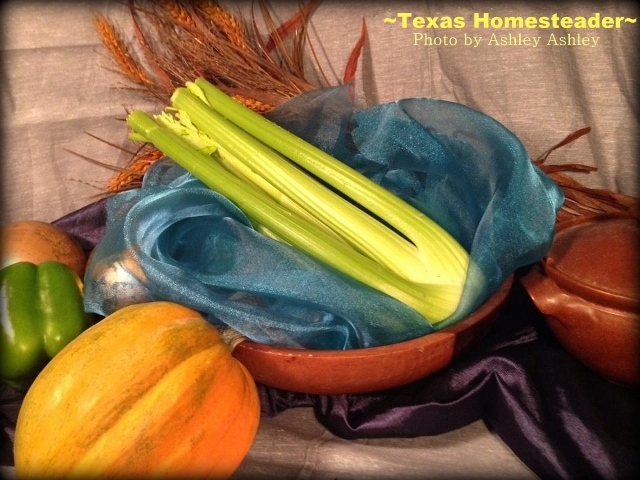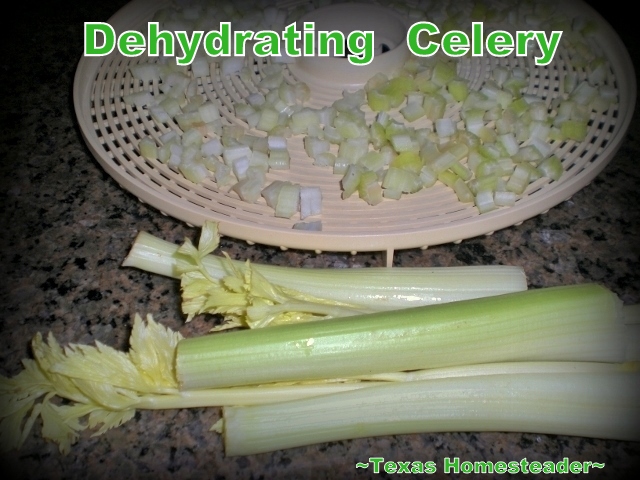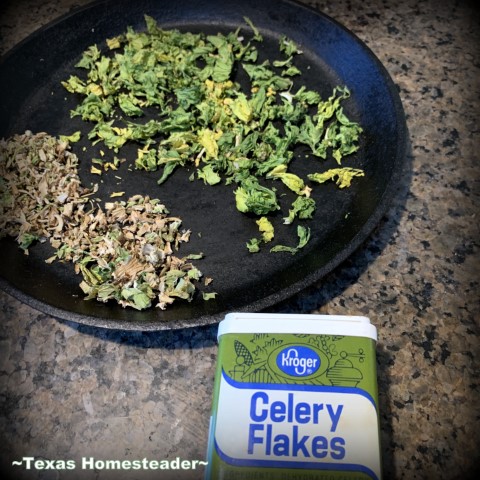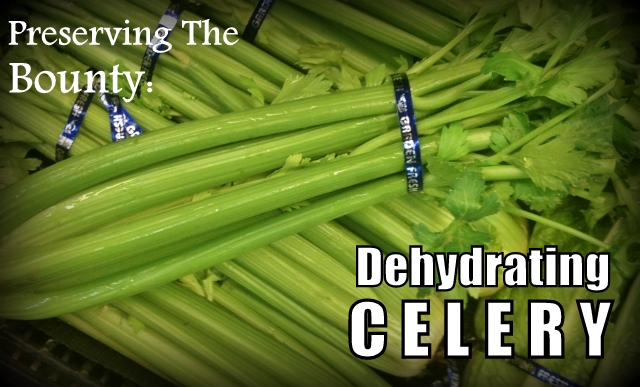by Texas Homesteader ~
I use celery from time to time when I’m cooking. But it’s always just an ingredient and never the main event in my kitchen.
So here’s what I do to make sure it’s all used up or preserved before it goes bad.

(because heaven knows *I* can’t make a photograph of a bunch of celery look like it belongs in an art studio!)
(Note: Some links in this post will take you to other related articles for further information. But links preceded with * are affiliate links. If you click and buy something I could receive a tiny commission.)
Fresh Celery Used Sparingly
RancherMan only tolerates a little celery taste. So it’s often only an ingredient I buy, use a little and place the rest of the bunch back in the refrigerator hoping to use it all before it goes bad.
I’ll use that fresh celery for several days. I like to add chopped celery in my chicken salad spread – but certainly not an entire bunch!
So I make sure to dehydrate the rest of the celery while it’s still fresh. That way I can use it to flavor our food later.
Dehydrating Celery – Blanche or No?
Blanching celery is not necessary to dehydrate it. But it’s said to result in a softer product when it’s rehydrated later. But to be honest I never do and it always turns out just fine for me.
To blanch celery just chop it into the pieces you’ll be dehydrating and drop it in boiling water for about 30 seconds
Then remove the celery from the water using a sieve and drop it into ice water for about 2 minutes.
Now you’re ready to dehydrate your chopped celery.
Dehydrating Leftover Celery
I washed the celery well and chopped the ribs to reduce the length of the strings. Those can sometimes stay tough even after the celery is rehydrated. So shorter is better here.
To dehydrate my celery I brought out my * trusty countertop-sized dehydrator.
This small countertop version is perfect when there’s a smaller amount to be dehydrated. (I’ve used the dehydrator lots this year!)
But what about when I have almost an entire bunch of celery to dehydrate?
Dehydrating A Full Bunch of Celery using an Excalibur Dehydrator
I also have a large 9-tray *Excalibur Dehydrator. I use that one when dehydrating larger quantities of food. Those 9 roomy trays will dehydrate a lot!
I typically place the temperature on the ‘vegetable’ setting of 125 degrees F. and dehydrate for about 4-8 hours.
The dehydrating time for you can vary based on how thinly you chop your celery, how much airspace around your celery pieces, and even the relative humidity in your home.
For me, it usually takes about 4 hours.
How To Dehydrate A Small Amount of Celery
Sometimes just need to dehydrate small amounts of trimmings, say from a single rib of celery. Don’t worry, I still dehydrate it, but for FREE.
I Use Residual Oven Heat to Dehydrate those small bits when there’s not enough to even fire up the smaller dehydrator. No electricity used and no food waste!
I’ll chop the leftover celery ribs and the leaves and place them on a small low-side cast iron skillet. I slide it into the oven after it’s turned off from cooking something else but before the oven’s cooled completely.
The residual heat will help dry the celery for free!
How Do You Want Your Dehydrated Celery?
After the celery is dehydrated, there are two ways I enjoy for the finished product:
* Chopped Dehydrated Celery: Most of my dehydrated celery is chopped. That way I can include it in dishes where I typically like small bits of celery.
* Powdered Dehydrated Celery: Some of the dehydrated celery will be ground into a powder. I will sprinkle small amounts to my recipe to add that celery flavor without the actual chunks of celery being present.
Powdering the dehydrated celery is easy. I’ll put it into a *coffee grinder I keep just for grinding seasonings and herbs.
With a few quick pulses it’s quickly ground into a powder.
Storing Dehydrated Celery
The powdered celery is poured into a repurposed seasoning can I’ve had for years and stands ready to be used to flavor our food.
The dehydrated chopped celery is placed into a clean glass jar.
I can’t believe that entire leftover bunch of celery fits inside a tiny spice jar when it’s dehydrated!
So with a quick label the jar’s ready to be added to my herbs & spices drawer to be used throughout the year.
Dehydrated Celery Means No Food Waste
So by dehydrating this leftover celery I’ve kept it from being wasted. Plus I’ve kept myself from having to purchase yet more when I’m ready to make chicken salad again.
And I love the fact that dehydrated produce takes up just a fraction of the space as before it was dehydrated. Plus it uses no additional energy to store as would be the case with freezing.
Rehydrating & Using Celery
I’ve read that 1.5 tablespoons of dehydrated celery is equal to 1 cup of fresh celery. But in my experience it seems to be about 1/4 cup dehydrated celery to 1 cup fresh celery. Maybe it depends on how small/thin you chop & dehydrate celery?
Top the dehydrated celery with boiling water and let it sit for about 15 minutes. Again, this is dependent upon how small/thin you’ve chopped your celery.
When it’s fully re-hydrated drain off any remaining water and stir the now-plumped celery right into your recipe for that distinctive celery taste.
There’ll be no more healthy yet expensive produce languishing in the depths of the refrigerator until it becomes science experiment fodder!
And you know how eliminating food waste appeals to me.
~TxH~
Other Dehydrating Posts
Garden Vegetables
- Preserving The Harvest: Dehydrating Fresh Carrots
- Cubed Tomatoes Dehydrated For Winter Cooking
- Preserving Produce: Dehydrating Celery
- Dehydrating Fresh Pumpkin For Easy Storage
- Dehydrating Spinach To Enjoy All Year Long
- Using A Dehydrator To Preserve Fresh Onions
- Dehydrating & Storing Cabbage
- Dehydrating Shredded Potatoes For Hash Browns
- Bell Pepper Dehydration
Fruits & Berries
Herbs
Other
- Simple Homemade Jerky Strips & Snack Sticks
- Easy Egg-Free Cotton Candy Meringue Cookies
- Dehydrating Tomato Sauce Into Leather For Pizza
See All Our Dehydrating Posts
C’mon by & sit a spell! Come hang out at our Facebook Page. It’s like sitting in a front porch rocker with a glass of cold iced tea – lots of good folks sharing! You can also follow along on Pinterest, on Twitter or on Instagram.
If you’d like to receive an email each time a new blog post goes live it’s EASY to Subscribe to our blog!
* A word about our Affiliate Link – We are currently enrolled as an Amazon Affiliate. Occasionally I will insert an affiliate link into one of my posts if I think it may be of interest to you and both of the items linked in this post really help me in my canning endeavors! I receive nothing from the manufacturer, but I love it & thought you might too. If you click on any of my affiliate links and buy something (almost anything, not just what was linked) I get a small referral percentage from Amazon. But here’s the really important part – the price you pay for your items is UNCHANGED.
When you buy something through the affiliate link it’s a great way to support this blog without anything coming out of your pocket so please click often!







Very cool idea! We dehydrate dark leafy greens and crush them to a powder so I can use it to make green smoothies — didn’t think about doing it for celery! Definitely got to try this.
Thanks so much for the advice! I just a got a dehydrator for Christmas, and I am trying to figure out all the things to dehydrate! This was a great read.
I cook ground beef for my old dog that has digestion problems and I add celery and carrots to the meat while it’s cooking. I cook a batch about every three days and getting out the cutting board, the knife and then washing them afterward is kind of a pain. It will be so much easier to do this and the water I include with the meat (I alternate between brown rice and barley) will make it so much easier. I’ve been thinking about include sweet potato to the mix and this would be a big help, too. Thanks for the tip.
Oh how I miss having a dehydrator now! I really like your point about the reduction on energy use to store the produce dehydrated, rather than frozen. I have been keeping my “extras” chopped and frozen, but this makes better sense.
I’ve been dehydrating celery for a while now and it’s paying off big-time. I look for nice celery on clearance racks and buy all I can find, or if it’s on a good sale, I’ll buy at least a dozen heads to dehydrate. Once I top and toe them, I cut them into lengths to fit my Vidalia Food Chopper which saves loads of chopping time. The chopped pieces are perfect for everything. For me, canning jars are perfect storage sizes and I seal them with my Food Saver for long term.
I need to do this!! I am not sure why I never thought of dehydrating celery before. Definitely frugal when we waste celery quite often. Thank you for linking up for Fabulously Frugal Thursday.
Wow, never thought of dehydrating celery. I do tomatoes, and sometimes apples and blueberries, but I will have to expand my repertoire! Thanks for sharing on Natural Living Mondays.
I have been dehydrating so much lately, I can’t imagine why I’ve skipped over celery! Thanks for sharing and linking up to What’d You Do This Weekend! Have a great day 🙂
Such a good idea – all the more reason I really need to get a dehydrator! Great post. Congrats on being chosen as a featured post on this week’s Wildcrafting Wednesdays! I hope you’ll join us again and share more of your awesome posts.
I do this too, Tammy. Love my dehydrator! When I freeze veggies for future use, they usually are freezer-burned or encased in off-odor-ice by the time I remember to use them. Dehydrating takes up so little space and the food lasts so much longer, doesn’t it?
Thank you for sharing at the HomeAcre Hop. I hope you’ll join us again this Thursday.
I think I need to invest in a dehydrator. I usually chop my leftover celery and freeze it.
I’ve never dehydrated anything before but I can see the usefulness of it.
I usually end up throwing away half of the bunch of celery myself. I thought about dehydrating some this fall, especially now when it’s on sale for Thanksgiving, but my friend gave me some SHE dehydrated! 😉